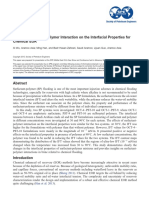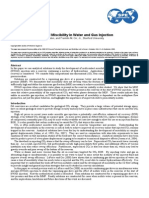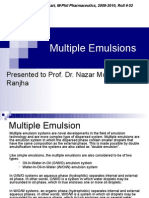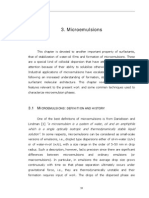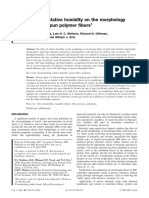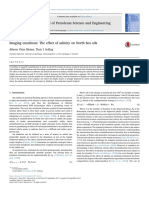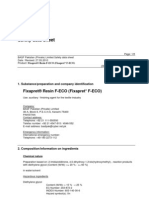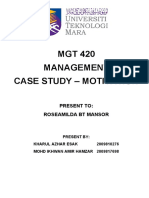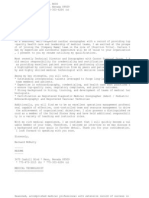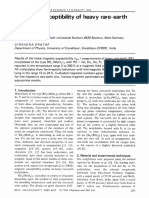Microemulsions: A Commentary On Their Preparation: J. Soc. Cosmet. Chem., 39, 201-209 (May/June 1988)
Microemulsions: A Commentary On Their Preparation: J. Soc. Cosmet. Chem., 39, 201-209 (May/June 1988)
Uploaded by
Sajida HafeezCopyright:
Available Formats
Microemulsions: A Commentary On Their Preparation: J. Soc. Cosmet. Chem., 39, 201-209 (May/June 1988)
Microemulsions: A Commentary On Their Preparation: J. Soc. Cosmet. Chem., 39, 201-209 (May/June 1988)
Uploaded by
Sajida HafeezOriginal Title
Copyright
Available Formats
Share this document
Did you find this document useful?
Is this content inappropriate?
Copyright:
Available Formats
Microemulsions: A Commentary On Their Preparation: J. Soc. Cosmet. Chem., 39, 201-209 (May/June 1988)
Microemulsions: A Commentary On Their Preparation: J. Soc. Cosmet. Chem., 39, 201-209 (May/June 1988)
Uploaded by
Sajida HafeezCopyright:
Available Formats
j. Soc.Cosmet. Chem.
,39, 201-209 (May/June 1988)
Microemulsions: commentary their preparation A on
HENRI L. ROSANO, JOHN L. CAVALLO,
DAVID L. CHANG, andJAMES H. WHITTAM, Department of Chemistry, City University New York,New York,NY 10031 of (H. L. R. ), ClairolResearch Stamford, (D. L. C. ), andShaklee Labs, CT U.S., Inc. SanFrancisco, 94111 (J.H.W.), General CA Foods USA, Tarrytown, 10625 (J.L.C.). NY
Received February 1987. 24,
Synopsis
A detaileddescription the concept microemulsions, they can be formed,factors on of how which affect stability,and recentapplications the focus this commentary. simplemethodfor determining are of A the amountof primary surfactant a given microemulsion shown,as well as data which emphasize for is the importance the orderof mixing based thermodynamic of on calculations six differentmicroemulsion for systems. We conclude that the formationreactions thesemicroemulsions of studies entropy-driven are reactions thus quite differentfrom the formationof coarse and emulsions their thermodynamic in properties.
INTRODUCTION
Emulsions play a key role in many of the cosmetics usetoday. Through the years we much has beenwritten on the formationand stabilityof theseoil-dispersed-in-water (o/w) or water-dispersed-in-oil (w/o) systems. Nevertheless, the cosmeticformulator still seeks understand create mostfavorable to and the cosmetically eloquent and functional products possible. Aesthetically appealing products can be formulatedas transparento/w or w/o dispersions calledmicroemulsions. possible The application these for systems rangefrom products with an extended shelflife to deliverysystems active for ingredients.
The pioneering work on microemulsions startedin 1943 (1). It wasonly in 1959 that Schulman coworkers coined word microemulsion thesecleartransparent and (2) the for dispersions. Thesesystems offer a great deal of uniqueness, only because their not of novel transparency, but also because the small dispersed of phase,usually having a
droplet diameter between 50-400fk.Today are there numerous theories thenature on
of their formationand stability, yet the practicalaspects their preparation still of are vague.Nevertheless, can be seen somerecent as by patents (TableI), specific applicationsfor microemulsions beingrecognized. are This reviewwill elucidate practical one
201
202
JOURNAL OF THE SOCIETY OF COSMETIC CHEMISTS
approach the scientistor cosmeticchemistto consider for when formulating these
unique transparentsystems.
The generalingredients requiredto make suchtransparent dispersions consist an oil of phase,an aqueous phase,a primarysurfactant (whichwill determine whetherthe emulsion is of the o/w or w/o type), and a secondsurfactant,known as a cosurfactant. Typically the cosurfactant a mediumchainlength (C5 - Co) alcohol.The primary is surfactant mainly absorbed the oil/waterinterface determines initial curvais at and the ture of the dispersed phase.The cosurfactant alsointeractsat the interfaceto form a mixedduplexfilm. The cosurfactant appears actin a dynamicstate.Initially it causes to a transitorylowering of the interfacialtensionnecessary during the formationof the dispersion.Secondly,as the cosurfactant distribution reaches equilibrium, it further distributes the interface become at to part of the interfacial film (oil/aqueous/surfactant molecules) with the primary surfactant. this point, the systemcan be a thermodyAt namicallystableswollenmixed micelie(o/w) or inverse mixed micelie(w/o) system.
SPECIFIC
COMBINATIONS
FORM
MICROEMULSIONS
What will becomeclear to the formulator is that unlike coarse emulsions, the formulaTable I
Microemulsion Technologies Documented RecentPatents in
Patent (Date)
1.
Tertiary oil recovery US 4587879 (860701), US 4556495 (851203). Diesel fuel composition, lubricant, antifreeze solution US 4599088 (860708), US 4605422 (860812), 4610222 (860909)
Pharmaceutical
2.
3.
JP 61044809 (860304)
4. Ink
US 4409039 (831011)
5.
Liquid detergent,household products JP 60106898 (850612), GB 2144763 (850313)
Reaction medium
6.
US 4611055 (860909), US 4521580 (850313)
7.
Drug deliverysystem
Jp 61044809 (860304)
8. Fiber finishes soil and water repelling for US 4566981 (860128)
Herbicide, pesticide JP 60231604 (851118)
9.
10. Personal products care
US 4460570 (840717)
PREPARATION
OF MICROEMULSIONS
203
tion of a stablemicroemulsion more specific is and thus greatly limited in variety. Coarse emulsions be stabilized a wide varietyof surfactants, can by application highof energyapparatus (turbinemixers,sonicators, etc.), and excipientingredients alter to viscosity and separation (gums, gelling agents).In general,stablemicroemulsions are veryspecific the ratioof surfactant/cosurfactant to disperse in used phase in a continA uousphase Six systems described Table II. An example this specificity the B. are in of is emulsion system consisting 2 X 10-3 molestearic of acid, 2 ml oil, and 16 ml 0.375 N KOH (System5, Table II). The authors reportedthat out of fifty-two alcohols, (3) only five weresuitablecosurfactants capable producing of transparent systems. o/w More recently, Rosano coworkers havemadea systematic and (4) studyon the formation of microemulsions prepared with alkyl sodiumsulfate (with the alkyl chaincontaining 12 to 16 carbon atoms)as the surfactant, and alkanes (octane throughhexadecane) as the oil, an aqueous solutionof alkyldimethylamine oxide(dodecyl throughhexadecyl) as the cosurfactant, and aqueous 5% NaC1, pH 12 brine solutionas the continuous phase.Table III summarizes systems the studied. It is readily seenthat out of the forty-fivecombinations, only fifteen resultedin the formationof transparent microemulsions, demonstrating highly specific the natureof the process.
THE
METHOD
A recognized and classical approach microemulsion to formulationis to utilize phase diagrams. Friberget al. havebeengreat supporters this technique of and haveelucidatedthe methodology numerous in papers (5-8). A majordrawback this approach to is the time it takesto develop phase the diagram,especially when one hasa variety of surfactants cosurfactants oils at his disposal useand evaluation. and and for Recently, automated systems havebeencommercialized offsetthe laborious to titrationsto determine the variousphases.The chief drawbackat the presenttime is the cost of such instrumentation, as well as accuracy.An alternative simpler approachis discussed
below.
Rosano suggested way to determinethe minimum amountof primary surfactant (9) a needed a particularsystem.In this theoretical for calculation,the minimum amountof primary surfactant requiredfor the microemulsion calculatedby determining the is
Table II
MicroemulsionSystems Continuous phase Dispersed phase
Systems 1
Surfactant
Cosurfactant
X ml water
2 ml n-octane
2 3
X ml water X ml water
0.5 ml C9Phenol-1.5-EO Csphenol-9-EO + 0.5 ml C9phenol-4-EO 2 ml n-decane 0.5 ml C9Phenol1.5-EO C9Phenol10-EO + 0.5 ml C9phenol-4-EO 2 ml n-hexadecane 0.5 ml C9Phenol-1.5-EO C9Phenol-9-EO
4 5
6
X ml toluene X ml 0.375 N KOH
+ 0.5 ml C9Phenol-4-EO 2 ml water 1.98 X 10-3M SDS 1-pentanol 2.3 ml n-hexadecane2.3 X 10-3M stearic acid 1-pentanol
1 gm SDS DDAO
x ml 5% NaC1 saline 1 ml n-decane
204
JOURNAL OF THE SOCIETY OF COSMETIC CHEMISTS
Table III
Microemulsion Formation From a GivenOil/Aqueous System
Cosurfactant(ADAO)
Na cetyl sulfate(surfactant) Paraffin phase oil
C8
NC
LDAO C16 C14
C12
C 10
NC
C 12
NC
C 14
NC
C 16
NC
5.5 (90%)* 3.0 (88%)
NC NC
NC NC
NC NC
NC NC
Cosurfactant(ADAO)
Na myristyl sulfate(surfactant) Paraffinoil phase
C8 ClO C12
LDAO
C14
NC
C16
NC
NC NC
C16 C14
C12
NC
NC
NC
6.6 (100%) 3.6 (96%)
6.9 (95%) 5.4 (97%)
7.8 (92%)
NC
7.3 (96%)
NC
Cosurfactant(ADAO)
Na lauryl sulfate (surfactant) Paraffin phase oil
C8 C 10 C 12
NC
LDAO
C 14
NC
C 16
NC NC NC
C16 C14 C12
9.0 (100%) 3.3 (90%)* 1.8 (99%)
NC 2.1 (98%)
3.3 (100%)
3.O (9O%)
NC
4.O (88%)
NC
Primarysurfactants: Sodiumalkyl sulfates. Cosurfactants: Alkyl dimethylamine oxide(ADAO). Oil phase: Co, C2, C4, C6 n-paraffins. C8,
Temperature: 30C.
*Viscousgel.
( )% transmittance (clarity)of system 520 nm. at
NC = non-clear system.
surface or, morereadily,the mono-molecular area interfacial film areanecessary form to between dispersed the phase and the continuous phase.
If a given volume (ml)ofa phase dispersed spherical V is into dropletsradius(), of r
the total volumeof the dispersed phase be expressed can as
V = a(4/3)'rrr 3 (1)
wherea is the total numberof droplets formedby the dispersed phase. The total surface areaA of the droplets is
A = a4'rrr 2
A = cn
(2)
(3)
wherec andn are the areaper surfactant molecule the number surfactant and of molecules,respectively. CombiningEqs. 1, 2 and 3 and solvingfor n, we find
n = (3V)/cr (4)
The value of c can be obtainedfrom the surface tensionvs. log concentration plot of the surfactantsolution or from monolayermeasurements. microemulsions, For the
PREPARATION
OF MICROEMULSIONS
205
upperlimit of r is 40 'nm (1/4 the wavelength visible of light), whilethe lowerlimit is
set by the surfactant chainlength. This simplecalculation provides minimum amountof surfactant the necessary cover to the interface.It doesnot take into account amountof surfactant the that is dispersed in both the aqueous oil phases otheraggregates and and that may form in solution.
continuous
Using the estimated amounts surfactants, coarse of a emulsionof dispersed phasein - ' formed by simple mixing o,-,,,rnonr since viscosity level. are
alwayslow.
To determine a transparent if dispersion possible, cosurfactant gradually is a is addedto the coarse emulsion. general, In mostcosurfactants liquidsandcanbe easilytitrated are into the emulsion while gentlemixing is applied the system If does not turn clearafter adding the cosurfactant an amountequivalent that of the primary surfactant, in to the system be considered can unacceptable. formulator The then hasan optionto alter the components the system. general,the cosurfactant usuallythe nonspecific of In is component,and soit is first altered.For example,if octanol the cosurfactant was used,one would consider selecting alcoholwith a differenthydrocarbon an chain length suchas decanol hexanol.New solutions the basecoarse or of emulsion prepared are and titrated
with the alcohol of choice.
Cosurfactants shouldbe chosen suchthat they do not prefer either the continuousor dispersed phase.The propercosurfactant be onethat will migrateto the oil-water will
interface and form a mixed surfactant/cosurfactant film.
The next optionavailable the cosurfactant if selection failsis to consider newprimary a surfactant. Recalculation the amountof surfactant madeand repeattitrationswith of is
the cosurfactant are conducted.
If the microemulsion does form by variationof the cosurfactant primary surfacnot and tant, the dispersed phaseshouldbe altered, in a logicalmanner.For example,if the dispersed phase an alkane,eitherincrease decrease chainlengthof the alkane is or the depending the requirements the formulation. on of An example this routineis shown Table III. While at first appearing of in complicated, this progression be conducted can rapidly by redetermining variety of cosurfactant/ a surfactant and dispersed-phase options
ORDER
OF MIXING
The question the orderor methodof preparation microemulsions long been on of has debated.One school thoughtis that these of systems thermodynamically are stableand thus the orderof mixing is inconsequential productstability. Anotherapproach to (10) is to consider these transparent dispersions true emulsions, thusthe stabilityis a as and functionof preparation. will attempt to shedsome We furtherlight on this question by
the following experiments.
Vapor pressure experiments wereundertaken o/w microemulsions gain someinfor to sight into the mechanism particleinteractionin thesesystems of (11). The microemulsionswere preparedwith 20 ml 5% NaC1, pH 11.2 (NaOH) solution, I gm sodium
206
JOURNAL OF THE SOCIETY OF COSMETICCHEMISTS
tetradecyl sulfate (STS), varying amounts octane, titrated clarity of and to withdodecyldimethylamine (DDAO,30%active). oxide Using Clausius-Clapeyron the equation
ln(p/po) -(AHvR)(1/T - 1/To) = (7)
where and arethevapor p Po pressureT and Hv theheat vaporization, R at To, of and thegas constant, vapor the pressure heats vaporizationbedetermined. and of can Figure
VOL. OCTAN[ ml
Figure Vapor 1. pressure for microemulsions5%NaCI 12)/sodium diagramthe system: (pH hexadecyl
sulfate/n-octane/dodecyldimethylamine 15-40C. oxide between Plotted a function amount n-ocas of of
tane.
PREPARATION
OF MICROEMULSIONS
207
1 depicts vaporpressure a functionof n-octane the as volumeat various temperatures. The presence an oil significantly of reduces vaporpressure the solution,similarto the of regularcolloidalsolutions high-molecular-weight or polymersolutions, wherebythe vaporpressure the system lessthan that of the continuous of is phase. Also revealed in the plots is the existence two microemulsion of regions distinguished the sharp by transition.In the low-pressure regionand hencelower oil content, the microemulsion particles isolated are non-interacting droplets encapsulated a surfactant andare by film dispersed uniformly in the continuous medium. At high oil contenr, the rise in the vapor pressure a reflection thedynamic is of equilibrium between particle merging and reforming. Using the data in Figure 1, it is possible estimate thermodynamic to the properties of this systemwith increasing adsorption cosurfactant. a given microemulsion of For system a particular at temperature, minimum amountof cosurfactant the requiredto form the microemulsion varies with the amountof continuous phase the system in while the quantities surfactant dispersed of and phase being held constant. are Plotting the amountof cosurfactant the volumeof continuous vs. phase reveals linearrelationship a (4,9,12,13). The mole fraction of the cosurfactant the interface,x, and in the at aqueous phase, b, canbe determined x from the intercept and the slope,respectively.
From the equation
AG -
-RT In Xi/Xb
(5)
the change free energywhich corresponds the adsorption cosurfactant the in to of at oil-waterinterface the presence surfactant in of film duringmicroemulsification be can calculated. the the same If procedure repeated various is at temperatures the change and in free energyis plotted vs. temperature, entropychange the accompanying cosurfactant adsorption be calculated can via
-- AS = (/AG//T)p
TableII liststhe six systems investigated TableIV summarizes calculated and the free
energy, enthalpy, entropy and values each thesystems. values AG areall for of The of
negative,signifyingthat microemulsification a spontaneous is process. However, the driving forces small;therefore, are other factors must be considered explainthe to formationof microemulsions satisfactorily. Also consider systems and 3: the differ1 encein their AG values resulted froma difference carbon in chainlengthof the oilsand AG changes a value - 275J/molperCH2 unit. It is interesting notethat in with of to the case w/o microemulsions, AG changes of the with a valueof + 230 J/mol per CH 2
unit (13).
Basedon thesecalculations experiments, formationof this set of microemuland the
sions an entropy-driven is process (4,12). The largeincrease interfacial and the in area formation a flexiblesurfactant/cosurfactant film whichproduces transitory of mixed a low interfacial tensionbetweenoil and water oppose entropyof the system.In the microemulsification freeenergy the decrease caused the entropyof dispersion by outweighs increase interfacial energy the in free from dispersion. the systems For studied, theentropy values all positive are with oneexception. Ruckenstein showed the (14) that adsorption surfactant the surface a dropisanother of at of factorwhichfavors dispersion; an increase interfacial in areais accompanied a decrease freeenergy an adsorbed by in of
208
JOURNAL OF THE SOCIETY OF COSMETIC CHEMISTS
surfactant molecule compared that of a molecularly to dispersed statein the bulk phase. More recently,Rosano (12) hasshownthat the adsorption cosurfactant of molecules at the dropsurface alsoreduces system the freeenergy.Miller and Neogi (15) developed a thermodynamic modelfor dilute microemulsion systems whichincludes combined the effects surfactant of film bendingand dispersion. The duplexfilm modelwas usedfor the interface.Their model yieldsinterestingpredictions microemulsion of behaviors, but some the parameters of used characterize to bending effects not readilyrelatedto are knownproperties the surfactant of (16).
Thus the freeenergyassociated formationof microemulsions negative,but quite with is
Table IV
Thermodynamic Properties O/W Microemulsions Table II of in
AG AH AS
System
1
2
(kJ/mole)
-17.4 -18.1 -19.6 -6.4 -14.8 - 13.9
(kJ/mole)
-6.8 -6.0 -25.0 18.7 8.7 11.3
(kJ/K mole)
3.5 X X -1.8 X 8.2 X 7.8 X 8.3 X
4.0
3 4 5 6
10 -2 10 -2 10 -2 10 -2 10 -2 10 -2
small.Therefore, orderof mixingplaysan importantrolein accelerating formathe the
tion of thesesystems.
SUMMARY
Microemulsions uniquelystablesystems the cosmetic are for formulator consider. to They, in general, moredifficultto formulate are compared regular to emulsions to due the specificity formulation of and, in manycases, orderof mixing. An approach the is summarized help develop to such systems an orderly in andrapidtime period.
REFERENCES
(1) T. P. Hoar andJ. H. Schulman, Transparent water-in-oil dispersions: oleopathic The hydromicelle,
Nature, 152, 102 (1943).
(2) J. H. Schulman, Stoeckenius, L. M. Prince,Mechanism formation structure miW. and of and of croemulsionselectron by microscopy,Phys. J. Chem., 1677(1959). 63,
(3) H. L. Rosano, Lan, A. Weiss, W. E. F. Gerbacia,andJ. H. Whittam, Transparent T. dispersions:
An investigation some thevariables of of affecting their formation, Colloid J. Interface 72, 233 Sci.,
(1979).
(4) H. L. Rosano, L. Cavallo, G. B. Lyons, J. and Microemulsion (Marcel Systems Dekker,New York,
1987), p. 259.
(5) S. Friberg, Microemulsions theirpotentials, and Chem. Technology, 6, 124-127 (1976). (6) R. ZanaandJ. Lans,Dynamics microemulsion, Microemulsions.' andDynamics of in Structure (CRC,
BocaRaton, FL, 1987), pp. 153-172.
(7) A. Belloca D. Roux, Phase and diagram criticalbehavior a quanternary and of microemulsion system, Microemulsions: Structure Dynamics and (CRC, BocaRaton, FL, 1987), pp. 33-77. (8) S. FribergandP. Bothorel, Microemulsions.' andDynamics, in Structure (CRC, Boca Raton,FL, 1987),
p. 219.
PREPARATION
OF MICROEMULSIONS
209
(9) H. L. Rosano, Microemulsions, J Colloid Interface 44, 242 (1973), andMethodfor Preparing Sci.,
Microemulsions U.S. Patent 4, 146, 499 March 27, 1979.
(10) W. Gerbacia H. L. Rosano, and Microemulsions: Formation stabilization, Colloid and J. Interface Sci.,
44, 242 (1973).
(11) J. L. Cavallo, and H. L. Rosano, Vaporpressure measurements an o/w microemulsion of system, J. Phys.Chem.,90, 6817 (1986). (12) H. L. Rosano, G. B. Lyons, and Freeenergy, enthalpy entropy and changes duringthe formation a of n-hexadecane/potassium stearate/water/1-pentanol microemulsion system, Phys.Chem.,89, 363 J.
(1985).
(13) K. S. Birdi, Microemulsions: Effectof alkyl chainlengthof alcohol and alkane,Colloid Polymer Sci.,
260, 628 (1982).
(14) E. Ruckenstein, The originof thermodynamic stabilityof microemulsions, Chemo Phys. Lett., 57, 517
(1978)
(15) C. A. Miller and P. Neogi, Thermodynamics microemulsions: of Combined effects dispersion of entropy dropsand bendingenergy surfactant of of films, Aiche, 26, 212 (1980). J., (16) S. Mukherjee, A. Miller, andT. Fort, Theoryof dropsizeand phase C. continuity microemulof sions, Colloid J. lnterfaceSci., 223 (1983). 91,
You might also like
- Emulsions - Formation, Stability, Industrial Applications PDFDocument243 pagesEmulsions - Formation, Stability, Industrial Applications PDFsandy44 wankhade100% (5)
- FDNY Forcible Entry Reference Guide: Techniques and ProceduresDocument177 pagesFDNY Forcible Entry Reference Guide: Techniques and ProceduresLexipol_Media_Group100% (4)
- Fixapret F ECODocument4 pagesFixapret F ECOSajida Hafeez0% (1)
- International Pharmaceutics: Journal ofDocument10 pagesInternational Pharmaceutics: Journal ofRafa ZonalmarketNo ratings yet
- Extraction Liquid-LiquidDocument11 pagesExtraction Liquid-LiquidHigokalNo ratings yet
- Technip Separations PDFDocument39 pagesTechnip Separations PDFProcess EngineerNo ratings yet
- Bonilla 2013Document10 pagesBonilla 2013MaringanNo ratings yet
- 1 s2.0 S002196732031044X AmDocument75 pages1 s2.0 S002196732031044X Amvanhongdangthi2004No ratings yet
- Unifac 6Document5 pagesUnifac 6lester33No ratings yet
- Regimes of Multiple Emulsions of W /O/W and O /W/O Type in The Continuous Couette-Taylor Flow ContactorDocument8 pagesRegimes of Multiple Emulsions of W /O/W and O /W/O Type in The Continuous Couette-Taylor Flow Contactorraghu_iictNo ratings yet
- Journal of Advanced Drug Delivery (JADD) : ISSN NO: 2348-3278 Volume 3, Issue 2 March-April - 2016Document8 pagesJournal of Advanced Drug Delivery (JADD) : ISSN NO: 2348-3278 Volume 3, Issue 2 March-April - 2016Nadya PrafitaNo ratings yet
- Physical Stability of Suspensions: Piscataway, NJ 08854Document19 pagesPhysical Stability of Suspensions: Piscataway, NJ 08854Prîñçê ÇhârmīñgNo ratings yet
- Heuristic Synthesis and Shortcut Design of Separation Processes Using Residue Curve Maps - A ReviewDocument18 pagesHeuristic Synthesis and Shortcut Design of Separation Processes Using Residue Curve Maps - A ReviewFDNo ratings yet
- Devarajan 2012 ReviewDocument6 pagesDevarajan 2012 ReviewNathali RicardoNo ratings yet
- Spe 0400959Document8 pagesSpe 0400959Ralf JonesNo ratings yet
- 1 s2.0 0021967394800235 MainDocument27 pages1 s2.0 0021967394800235 MainkmeriemNo ratings yet
- Estabilidad Pamoato PirantelDocument6 pagesEstabilidad Pamoato PirantelHéctor Fabio Leyton ArcosNo ratings yet
- Micro EmulsionsDocument6 pagesMicro EmulsionsShaheen GulamaniNo ratings yet
- Special Issue Honoring Don Mackay: Oil Spill Impact Modeling: Development and ValidationDocument16 pagesSpecial Issue Honoring Don Mackay: Oil Spill Impact Modeling: Development and Validationbrice mouadjeNo ratings yet
- Solvent-Resistant Nanofiltration Membranes: Katrien Hendrix and Ivo F. J. VankelecomDocument33 pagesSolvent-Resistant Nanofiltration Membranes: Katrien Hendrix and Ivo F. J. VankelecombrianNo ratings yet
- Surfactant Flooding ThesisDocument4 pagesSurfactant Flooding Thesisjuliasolembellevue100% (2)
- Extractive Distillation of Acetone/Methanol Mixture Using Water As EntrainerDocument8 pagesExtractive Distillation of Acetone/Methanol Mixture Using Water As EntrainernataliaNo ratings yet
- The Study of Mass Transfer Coefficient in Membrane Separation For Produced WaterDocument11 pagesThe Study of Mass Transfer Coefficient in Membrane Separation For Produced Waterbiee04No ratings yet
- Interacción Surfactante-Polímero Sobre Las Propiedades Interfaciales de Una SustanciaDocument9 pagesInteracción Surfactante-Polímero Sobre Las Propiedades Interfaciales de Una SustanciaJesus BcNo ratings yet
- Micro Emulsion System To Breakup W-O EmulsionsDocument5 pagesMicro Emulsion System To Breakup W-O EmulsionsArmando SorondoNo ratings yet
- Spe 116119 MS PDocument8 pagesSpe 116119 MS P姚嵩No ratings yet
- SURFACTANTDocument15 pagesSURFACTANTRachel PanjaitanNo ratings yet
- SPE-179701-MS Predicting Microemulsion Phase Behavior For Surfactant FloodingDocument18 pagesSPE-179701-MS Predicting Microemulsion Phase Behavior For Surfactant FloodingJingyuan GuanNo ratings yet
- Critical Micelle Concentrations of Nonionic Surfactants in Organic Solvents: Approximate Prediction With UNIFACDocument7 pagesCritical Micelle Concentrations of Nonionic Surfactants in Organic Solvents: Approximate Prediction With UNIFACEduardo CreattoNo ratings yet
- Intemational Journal of PharmaceuticsDocument6 pagesIntemational Journal of PharmaceuticsHelen JullsNo ratings yet
- Multiple EmulsionsDocument31 pagesMultiple Emulsionsufahad100% (1)
- Grid-Based Leakoff ModelDocument14 pagesGrid-Based Leakoff Modelamramazon88No ratings yet
- Chapter 1Document49 pagesChapter 1CharleneKronstedtNo ratings yet
- Liquid-Liquid Partition Chromatography in Natural Product IsolationDocument14 pagesLiquid-Liquid Partition Chromatography in Natural Product IsolationkmeriemNo ratings yet
- 05-1994-Heuristic Synthesis and Shortcut Design of Separation ProcessesDocument18 pages05-1994-Heuristic Synthesis and Shortcut Design of Separation Processesehsan zeraatkarNo ratings yet
- Selection Method of Surfactants For Chemical Enhanced Oil RecoveryDocument8 pagesSelection Method of Surfactants For Chemical Enhanced Oil RecoveryAdhita MeryantoNo ratings yet
- 7 KrisTriBasukiDocument26 pages7 KrisTriBasukiLoraNo ratings yet
- NMR Peak AssignmentDocument9 pagesNMR Peak Assignmentafefhtdof100% (1)
- Micro Emulsion TechnologyDocument3 pagesMicro Emulsion TechnologyRexona KhanomNo ratings yet
- 3 MicroemulsionsDocument37 pages3 Microemulsionsمرتضى عباسNo ratings yet
- 2008 Effect of RH On Electrospun NanofibersDocument10 pages2008 Effect of RH On Electrospun NanofibersEliton Medeiros Candido de MacêdoNo ratings yet
- Development of Alternative Methanol/dimethyl Carbonate Separation Systems by Extractive Distillation - A Holistic ApproachDocument26 pagesDevelopment of Alternative Methanol/dimethyl Carbonate Separation Systems by Extractive Distillation - A Holistic ApproachgubonwunNo ratings yet
- A Correlation For Phase Behavior of Nonionic SurfactantsDocument11 pagesA Correlation For Phase Behavior of Nonionic SurfactantsbarretoquinterocdNo ratings yet
- Dickhout 2017Document16 pagesDickhout 2017VishnuShantanNo ratings yet
- Oil-In-Water Nanoemulsions For Pesticide FormulationsDocument6 pagesOil-In-Water Nanoemulsions For Pesticide FormulationsiswanadaNo ratings yet
- Laboratory Journal - Business Web For Users in Science and Industry - Liquid-Liquid Chromatography - 2017-03-16Document5 pagesLaboratory Journal - Business Web For Users in Science and Industry - Liquid-Liquid Chromatography - 2017-03-16anchizNo ratings yet
- A Systematic Synthesis Framework For Extractive Distillation ProcessesDocument24 pagesA Systematic Synthesis Framework For Extractive Distillation Processesconker4No ratings yet
- Mechanical Dewatering of SuspensionDocument7 pagesMechanical Dewatering of SuspensionAgung Prasetya ChandranenaNo ratings yet
- Identification of Phases of Various Oil, Surfactant/ Co-Surfactants and Water System by Ternary Phase DiagramDocument9 pagesIdentification of Phases of Various Oil, Surfactant/ Co-Surfactants and Water System by Ternary Phase DiagramBushra ShaukatNo ratings yet
- Microemulsions: As Drug Delivery System: Amul Mishra, Ridhi Panola, A.C. RanaDocument8 pagesMicroemulsions: As Drug Delivery System: Amul Mishra, Ridhi Panola, A.C. RanaGargi SharmaNo ratings yet
- 1 s2.0 0168365989900734 MainDocument7 pages1 s2.0 0168365989900734 MainJôsy SouzaNo ratings yet
- 6.1 Formation of EmulsionsDocument39 pages6.1 Formation of Emulsionsحيدر الوائليNo ratings yet
- Cgrowth Tut3Document12 pagesCgrowth Tut3hema22No ratings yet
- Keurentjes 1992Document7 pagesKeurentjes 1992Subah TasnimNo ratings yet
- Journal of Petroleum Science and Engineering: Alberto Vi Nas Mu Noz, Theis I. SøllingDocument5 pagesJournal of Petroleum Science and Engineering: Alberto Vi Nas Mu Noz, Theis I. SøllingAlexander LopezNo ratings yet
- Isolation of Interfacially Active Molecules From Brazilian Oils and Characterization by High Resolution Analytical TechniquesDocument12 pagesIsolation of Interfacially Active Molecules From Brazilian Oils and Characterization by High Resolution Analytical TechniquesQuimico maniaNo ratings yet
- Boduszynski - Composition of Heavy Petroleums 2, 1988Document17 pagesBoduszynski - Composition of Heavy Petroleums 2, 1988oreamigNo ratings yet
- Static Mixer SMVDocument13 pagesStatic Mixer SMVarun manchekarNo ratings yet
- Surface Chemistry of Surfactants and PolymersFrom EverandSurface Chemistry of Surfactants and PolymersRating: 5 out of 5 stars5/5 (1)
- Groundwater Remediation: A Practical Guide for Environmental Engineers and ScientistsFrom EverandGroundwater Remediation: A Practical Guide for Environmental Engineers and ScientistsNo ratings yet
- PriSecHthDpt PW FormDocument4 pagesPriSecHthDpt PW FormSajida HafeezNo ratings yet
- Helizarin Yellow FFGR MSDSDocument7 pagesHelizarin Yellow FFGR MSDSSajida HafeezNo ratings yet
- Fixapret F-ECO TIDocument5 pagesFixapret F-ECO TISajida HafeezNo ratings yet
- Basosoft FF-EUK NewDocument4 pagesBasosoft FF-EUK NewSajida HafeezNo ratings yet
- Basosoft FF Euk MsdsDocument7 pagesBasosoft FF Euk MsdsSajida HafeezNo ratings yet
- Fixapert F-Eco MsdsDocument8 pagesFixapert F-Eco MsdsSajida HafeezNo ratings yet
- Final ReportDocument23 pagesFinal ReportSajida HafeezNo ratings yet
- Fixapret Resin F-ECODocument8 pagesFixapret Resin F-ECOSajida HafeezNo ratings yet
- NEC Handbook 2005 About The Editors PDFDocument2 pagesNEC Handbook 2005 About The Editors PDFCèsar GarzónNo ratings yet
- Teste Şi Fişe de Lucru Pentru Clasele Ii-Iv: Test Paper 4 GradeDocument15 pagesTeste Şi Fişe de Lucru Pentru Clasele Ii-Iv: Test Paper 4 GradeclaudiaNo ratings yet
- Lms-November FinalDocument6 pagesLms-November FinalAlkatraz Maison JarNo ratings yet
- Emr Data Migration Project Plan v1.4Document35 pagesEmr Data Migration Project Plan v1.4marcpitreNo ratings yet
- National Agro Food Policy PaperDocument25 pagesNational Agro Food Policy PaperAlangAki HanafiahNo ratings yet
- Causes of Death in HIV-infected Persons Who Have Tuberculosis, ThailandDocument7 pagesCauses of Death in HIV-infected Persons Who Have Tuberculosis, Thailandfaradila aninda raesaNo ratings yet
- Northwell Health, IncDocument12 pagesNorthwell Health, IncKaushik DuttaNo ratings yet
- PW 23S6A PrimaryResearch Draft2 9augDocument8 pagesPW 23S6A PrimaryResearch Draft2 9augJon Yew HoNo ratings yet
- 6-In-1 Cable Tester Instruction Manual 6-In-1 Cable Tester Instruction ManualDocument1 page6-In-1 Cable Tester Instruction Manual 6-In-1 Cable Tester Instruction Manualthared33No ratings yet
- PV - Livre Blanc - SEASON REPORT AW 24 25Document53 pagesPV - Livre Blanc - SEASON REPORT AW 24 25degtyartatiana333No ratings yet
- Leading Causes of MortalityDocument12 pagesLeading Causes of MortalityJayricDepalobosNo ratings yet
- JFR FMCW Radar Level Transmitter - B0 - 65774187Document10 pagesJFR FMCW Radar Level Transmitter - B0 - 65774187ciocioi iancuNo ratings yet
- NPDADocument52 pagesNPDAAlondra MangandogNo ratings yet
- Technical Elective ReportDocument43 pagesTechnical Elective ReportSaajan SharmaNo ratings yet
- Bonding Basics 2010Document9 pagesBonding Basics 2010AneilRandyRamdialNo ratings yet
- The Advantages and Disadvantages of Using HVDC To Interconnect AC NetworksDocument5 pagesThe Advantages and Disadvantages of Using HVDC To Interconnect AC NetworksNidhiNo ratings yet
- Maquina de Biodiesel A Partir de Aceite CaseraDocument2 pagesMaquina de Biodiesel A Partir de Aceite CaseraAndres Echeverri CastroNo ratings yet
- Flash and Fire Point and Aniline PointDocument12 pagesFlash and Fire Point and Aniline PointMaten NasradinNo ratings yet
- Selected Works in Contemporary TimesDocument46 pagesSelected Works in Contemporary TimesAcey Acey AceyNo ratings yet
- MGT 420 Management Case Study - Motivation: Present To: Roseamilda BT MansorDocument4 pagesMGT 420 Management Case Study - Motivation: Present To: Roseamilda BT MansorkimimuraNo ratings yet
- Long Term Capital Management - Case StudyDocument10 pagesLong Term Capital Management - Case StudyAnas GodilNo ratings yet
- Director, Clinical Coordinator, Vascular, Cardiac SONOGRAPHERDocument4 pagesDirector, Clinical Coordinator, Vascular, Cardiac SONOGRAPHERapi-121412644No ratings yet
- Solar Trifold BrochureDocument2 pagesSolar Trifold BrochureNavin MohtaNo ratings yet
- Disaster Readiness and Risk Reduction: Quarter 1 - Module 6 Earthquake HazardsDocument24 pagesDisaster Readiness and Risk Reduction: Quarter 1 - Module 6 Earthquake Hazardsre8246224No ratings yet
- Substance AbuseDocument15 pagesSubstance AbuseDivij SaxenaNo ratings yet
- Rix No2 - 2ps2b-.85 Rev eDocument64 pagesRix No2 - 2ps2b-.85 Rev eShau WilliamNo ratings yet
- Magnetic Susceptibility of Heavy Rare-Earth MolybdatesDocument2 pagesMagnetic Susceptibility of Heavy Rare-Earth MolybdatesJoel FélixNo ratings yet
- Brochure Vestas V90 V100 2MW 3MWDocument16 pagesBrochure Vestas V90 V100 2MW 3MWtstefan88No ratings yet
- Raw MaterialsDocument8 pagesRaw Materialsmahmuda chowdhury100% (1)























